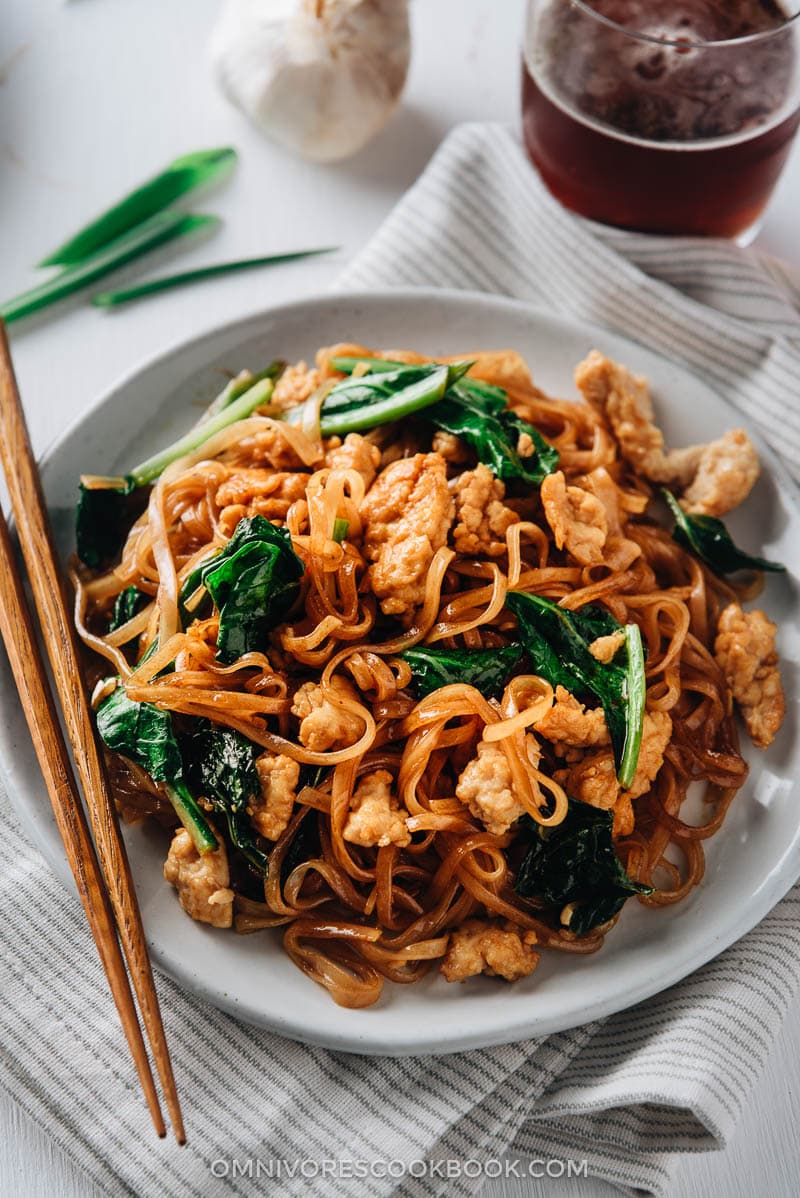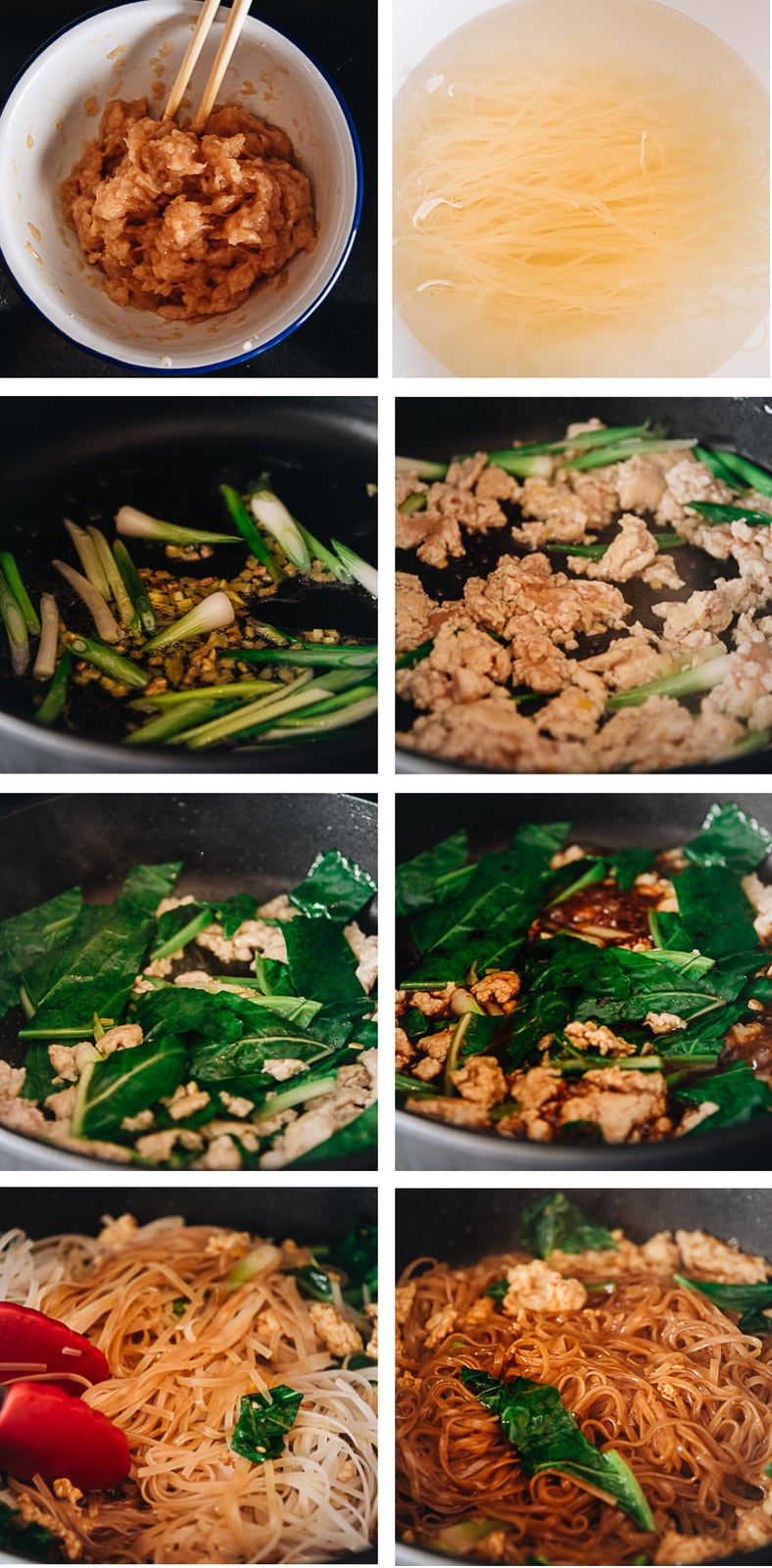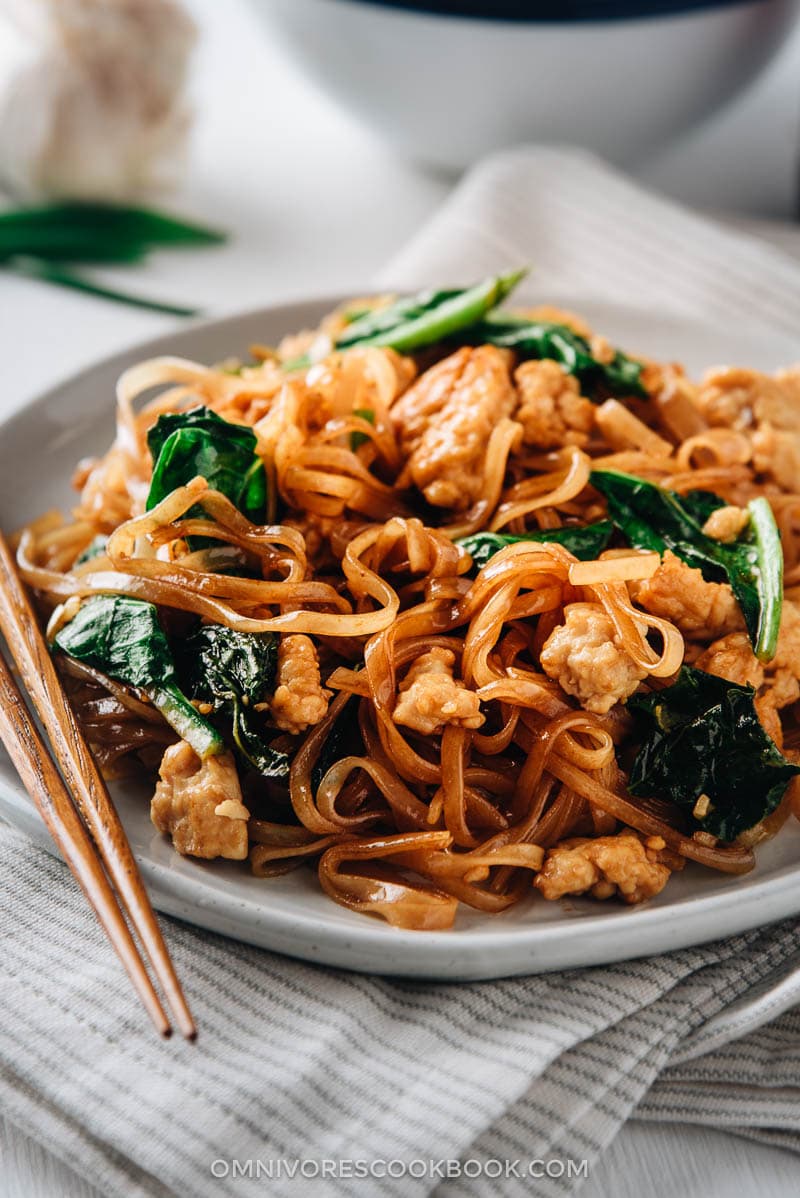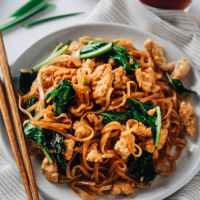Fried noodles are a perfect way to create a hearty, quick, and healthy one-dish meal. This recipe introduces an optimized workflow and numerous tips for creating a great noodle dish with minimal effort. {Gluten-Free}

I have come across quite a lot of complaints on foodie forums, that creating a great Asian fried noodle dish requires too much effort. This is only half true.
I agree, Asian stir fried dishes generally involve longer ingredient lists, more chopping, and more attention than, say, a casserole dish. But what you can do is to optimize your workflow to create a delicious dish with minimal effort and ingredients to bring out the best flavor.
How to make great fried noodles in less time
-
Use rice noodles instead of wheat noodles
Although there are many types of noodle in Chinese cuisine, and although different recipes call for very specific noodles, I found that rice noodles are the perfect option for a quick weekday meal, because you can skip the process of boiling water and you’re unlikely to ruin the dish by picking the wrong type of noodle.
-
Prep the rice noodles properly
To prepare rice noodles properly, make sure you cut them into shorter sticks before soaking. If you’re using a wok and steel spatula, you can chop the noodles during the stir fry, but if you’re using a nonstick skillet with tongs (like I do in this recipe), you’ll need to do this step before cooking, so the noodles won’t get too tangled.
Soak noodles in hot water for 5 to 7 minutes, until al dente. Drain and rinse them with cold water, to stop the cooking process. You can add a few drops of oil and toss the noodles, so they won’t stick together.

-
Use plenty of green onion
Chinese cooking often requires ginger, garlic, and green onion. This means a lot of cutting and extra prep time. To shorten the ingredient list, you can skip the garlic and use plenty of green onion (using 6 to 8 green onions in a stir fried dish for two is the proper amount). You can skip ginger too, but I recommend you to use it whenever you can.
Quick tips:
- Read this post on how to prep and freeze ginger, so you can shorten your prep time even further.
-
A great sauce does not require too many ingredients
You can create a great fried noodle sauce by using the right amount of soy sauce, sugar, and salt. I used the combination of light and dark soy sauce to add a nice brown color to the noodles, but you can simplify this by only using one type of soy sauce.
If you want to make your noodles even more flavorful, you can skip the salt and use 1 tablespoon of oyster sauce or use hoisin sauce, instead.
The other way to add flavor to the sauce is to make homemade chicken stock using leftover bones (you might need to dilute it with water since homemade stock can be very thick). It makes the dish much richer than it would be if using store-bought stock.
-
Use animal fat to immediately make your noodles super rich
Like I mentioned in the soy sauce fried rice recipe, using a bit of animal fat (chicken fat, duck fat, or bacon fat) will create a super rich flavor. It is not necessary in this recipe, but if you happen to have some animal fat in the fridge, don’t forget to use it!
-
Use ground meat and mustard greens to shorten the cooking time
Many fried noodle recipes require you to cook the meat and vegetables separately so that each ingredient will be properly cooked (such as this beef chow fun recipe). I tried to shorten the process in this recipe by using ground meat and mustard greens, which don’t need to be taken out of the skillet.
Ground meat is less prone to becoming overcooked than sliced meat. However, I do find it very helpful to do a brief marinade to make the meat tender and more flavorful. If you’re using ground turkey, pork, or beef, you can skip the potato starch, because these eats contain more fat and will stay tender during cooking.

-
Do not add too much of the ingredients
Proportioning a well-balanced fried noodles dish is like choosing pizza toppings – less is more. If you crowd your pan with too much stuff, the noodles will easily become mushy and/or flavorless, because crowding the pan takes so much heat out of the metal that the ingredients don’t get seared properly.
-
Use an efficient workflow
The order should be: soak the noodles => marinate the meat => mix the sauce => prep and chop the herbs and veggies while soaking the noodles => stir fry
It might take a bit more time if you’re cooking this dish for the first time, but once you get used to the process, prep should take you ten minutes and cooking five minutes.
Bonus tips for tweaking the fried noodles
How to make this dish gluten-free
Use gluten free tamari soy sauce to replace the soy sauce and skip the potato starch in the marinade. Like I mentioned above, you can create tenderer meat by using ground turkey, pork, or beef. I found ground chicken to be too lean. Skipping the cornstarch will result in tougher chicken.
How to make this dish vegetarian
To make the dish vegetarian, skip the ground meat and use mushrooms or chopped tofu instead. Replace the chicken stock with vegetable stock.

More delicious noodle recipes
- Easy Singapore Noodles
- Real-Deal Beef Chow Fun
- 15-Minute Garlic Noodles
- Easy Soy Sauce Noodles
- Real Deal Sesame Noodles
- Hokkien Noodles (Hokkien Mee)
If you give this recipe a try, let us know! Leave a comment, rate it (once you’ve tried it), and take a picture and tag it @omnivorescookbook on Instagram! I’d love to see what you come up with.

15-Minute Fried Noodles
Ingredients
- 1/2 pound (220 grams) wide dried rice noodles
Marinade
- 1/2 pound (220 grams) ground meat (beef, chicken, pork, or turkey) or shrimp
- 2 teaspoons Shaoxing wine (or Japanese sake, or dry sherry)
- 1 teaspoon potato starch
- 1/2 teaspoon salt
Sauce
- 1/4 cup chicken stock
- 2 teaspoons light soy sauce
- 1 tablespoon dark soy sauce (*see footnote 1)
- 1 tablespoon sugar
- 1/2 teaspoon salt (or 1 tablespoon oyster sauce, or hoisin sauce)
Stir-fry
- 2 tablespoons peanut oil (or animal fat)
- 6 green onions , chopped into long slices (separate the white and green parts)
- 1/2 tablespoon ginger , grated
- 2 cups mustard greens , chopped
Instructions
- Cut rice noodle threads into 8-inch (20 cm) lengths with a pair of scissors (*see footnote 2) and transfer them to a large bowl. Add hot tap water to cover. Be sure to submerge the rice noodles. Let sit for 5 to 7 minutes (*see footnote 3), until tender. The noodles should be flexible but remain al-dente (*see footnote 4). Drain. Add a few drops of vegetable oil and gently toss a few times.
- While soaking the noodles, prepare marinade, sauce and cut veggies.
- Combine ground meat (or shrimp), Shaoxing wine, potato starch, and salt in a small bowl. Mix well.
- Combine chicken stock, light soy sauce, dark soy sauce, sugar, and salt in a small bowl. Mix well.
- Place all the ingredients and a pair of tongs (or pair of chopsticks) next to your stove.
- Heat oil in a large nonstick skillet (or a wok) over high heat until hot. Add ginger and half the green onion (all the white parts). Cook and stir until it starts to sizzle.
- Add ground meat. Cook and stir until the surface is slightly charred, but not cooked through yet.
- Add mustard greens and the rest of the green onion (all the green parts). Cook and stir for 30 seconds.
- Pour in sauce. Stir a few times. Add rice noodles. Toss and stir with a pair of tongs, until the liquid is fully absorbed. Remove skillet from stove. Carefully taste the noodles. If the noodles are still a bit tough, you can return the skillet to the stove and pour in 3 to 4 tablespoons chicken stock (or water). Continue tossing and stirring until the liquid is absorbed.
- Transfer everything to serving dishes. Serve immediately as a main dish.
Notes
- The dark soy sauce will add a nice dark brown color to the noodles. You can use 1 tablespoon + 1 teaspoon soy sauce instead of using the combo of light and dark soy sauce. The noodles will be seasoned correctly, just with a lighter color.
- By cutting the noodles into shorter lengths, they won’t be tangled together during stir-frying and will be easier to eat.
- The soaking time varies depending on the noodles and on the temperature of the water. If you’re using boiling water, the soaking time might shorten to 3 minutes. I used the hottest water I could get from the tap in this recipe and it took 7 minutes.
- It is OK if the noodles are still a bit tougher than they should be. You can fix this during stir-frying, by adding a bit more chicken stock (or water) and cooking until the noodles are tender. On the other hand, if you soak the noodles for too long, they will be more prone to stick together and will turn mushy after cooking.













I love these sorts of posts that you do, Maggie. Noodle stir fries are my favourite, but I never really know what I’m doing when I’m making them. It’s great to have some tips from a pro!
Hope you have a great holiday!
Helen
Great to hear this post is helpful Helen! You too, Happy New Year and have a wonderful holiday! 🙂
You never fail to make my mouth water!!! This dish looks sooo good! And best thing about rice noodles is they’re already GF 😉
The more I cook, the more I realized it’s very easy to convert lots of Chinese dishes to fit GF diet. I will put this one my project list, and write an article about how to convert Chinese recipes into GF ones. Thanks for the idea Rebecca 🙂
Maggie, I am so hungry right now! I absolutely adore rice noodles. But they always seem to require so much work. I am guilty to say I have never made any at home. These look really easy and pack with flavors. I am very excited and can’t wait to try it!
The noodle dish might look daunting to make, but believe me, they are super fast and easy when you get the idea of it! Hopefully the information is helpful, because the freshly made noodles that just came off the stove are the best 😉
I’ve never attempted Chinese cuisine before because I felt kind of clueless when it comes to the ingredients, cooking techniques, and equipment but this helps so much. The step by step tips and the photos in the instructions really break it down. Looks delicious!
That’s exactly how I feel when it comes to baking! I simply cannot figure out when my butter is done without a picture. I’m so glad to hear you find these information helpful Megan 🙂
These are all fantastic tips Maggie. While I prefer the wheat noodles over the rice, they are just as tasty, just a different texture.
That photo of you chicken stock looks exactly like mine in the fridge with a big scoop taken out – too funny!
Great getting to know you this past year and for sharing a dinner with us here in San Diego. Merry Christmas to you both!
I love wheat noodles too. Maybe because I haven’t managed to find a great brand yet, the wheat noodles I used often ended up mushy after the stir-fry. That’s why I converted to rice noodles after many attempts. Next time I’ll try to use spaghetti. I imagine it will be a great substitute for Chinese wheat noodles.
It was great to meet you in person in San Diego! Wish we will gather together again in 2016 (I believe we will at some blog conferences)! Happy New Year to you and wish you have a wonderful holiday 🙂
These look so yummy! I love how you provide the step by step photos and also provide all the great tips for making a perfect fried noodle dish!
This was great. I love rice noodles and was looking for something other than Pad Thai to make.
I love Pad Thai too! This recipe was actually inspired by a rice noodle dish I had in a Thai restaurant. It will be a good alternative if you want to make something new with rice noodles 🙂 Happy cooking!
OMG, using no-flavor rice noodles I was done in 15 minutes. If I had used a flavorful wheat or egg noodle it would have taken me a whole 30 minutes. Thank you so much from a very important, busy person.
I’m glad to like the recipe Fred! Yes rice noodles will save you so much time because you only need to soak them for a bit. That’s why I personally always prefer to stir fry with them, or leftover rice, so I can save the noodle boiling process 🙂
Hi Maggie! I find the step-by-step instructions to be quite helpful. It is better than a video in which you have to pause. This way I can take my time on whatever step I’m one & reference previous steps without having to rewind the video.
I like the step-by-step method, as it is easy to follow. Plus, you offer alternate suggestions.
Maggie, the photos are drool worthy! Absolutely gorgeous. I love making noodles.
Thus was great. Used small pieces of pork instead of beef. Swiss chard and the oyster sauce vs salt.
Hi Tennie, I’m glad to hear the recipe worked for you! These substitutions sound great and I really love the addition of oyster sauce. Thanks for sharing 🙂
Such helpful tips. Thanks!!! My husband is Chinese,and I’m not Asian so
didn’t grow up with these type of dishes,only if eating at Chinese restaurant from time to time….So cooking “Asian style” is a challenge still after 2 years of marriage. Your tips have definitely helped 🙂
Thanks
Hello, loved your recipe! I’ve been desperate to make it but wasn’t able to find detailed instructions. I just made it for my family and they loved it! Thank you so much
I’ve made this many times with variations – sometimes I use beef, sometimes chicken, sometimes pork, and I will use whatever dark leafy green I have on hand. I like to add a little garlic and chili paste. It’s so good and easy, always hits the spot! Thank you!!
Thank you VERY much for this post! I changed out the vegetables to those I have in my garden but your approach to the noodles was PERFECT! I’ve never been able to do them this nicely before.
Love the look of this recipe and can’t wait to try. Quick Q though. Does the sauce taste sweet coz of the sugar? I prefer a savoury base. Do you reckon i could leave the sugar out and use the 1tbspn oyster sauce as recommended? Thanks!
The sauce doesn’t taste strongly sweet. The sugar is there to add flavor and balance the sauce. If you worry about the sauce being sweet, I would use 1 tablespoon oyster sauce with a tiny pinch of sugar. Although you will need to reduce the salt if using oyster sauce.
This fried noodles is absolutely delicious! The noodle is perfect, even whether what time of day you prefer to eat them. My family loves them, too! Thanks to Karman Foods for my easy and fast delivery Asian ingdredients.
This is in reference to your how to store ginger page. Comments aren’t enabled. I wanted to suggest that another way I like to use is to grind both ginger and garlic in the food processor to the desired chunkiness (sometimes to a fine paste) and put it in a glass bowl with a tight rubber seal. Then add enough neutral oil to it and mix it. It lasts for weeks and I can pull out as much as I need when stir frying or any recipe that calls for garlic and ginger. The minuscule amount of oil doesn’t put off the dish that I could ever notice.